


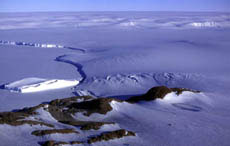 Dramatic climate changes in the last Ice Age
Dramatic climate changes in the last Ice Age
Enormous ice sheets melted in the middle of the last Ice Age. Land areas that had been depressed by the ice were inundated. The sea level rose very rapidly. In some large river valleys in north-western Russia, the sea reached 200-300 kilometres further into the country than it does today.
By Gudmund Løvø
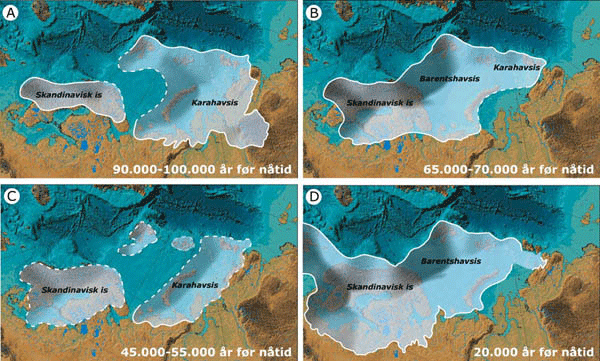
- The climate 60 000 years ago was cooler than today, but the vigorous melting of large ice masses in America and the Antarctic gave a chain reaction all the way to the Barents Region, Eiliv Larsen, a geologist at the Geological Survey of Norway (NGU), tells us.
He says that scientists have always known that large natural variations in climate took place during glaciation periods, both between separate ice ages and within each individual ice age. Now the Earth is faced with an additional challenge; global warming caused by man.
Changing oceans
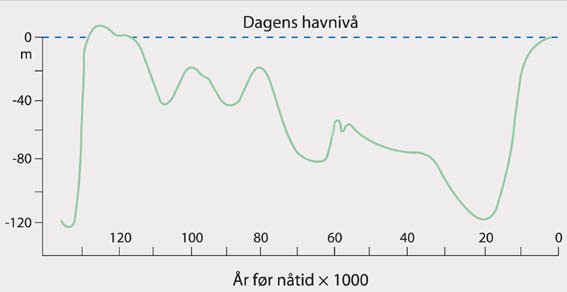 |
| THE SEA RISES: The sea level has varied greatly since the end of the penultimate ice age, through the last interglacial and the last Ice Age, up to the present time. The zero level is the present-day sea level. |
- The ice in the Barents Sea began to float and break up in response to the rising sea level 60 000 years ago. It became thinner and rapidly melted completely. Enormous volumes of meltwater poured into the sea, and large glacial lakes were drained. The huge quantities of freshwater had a great influence on the circulation in the oceans and on the climate, Eiliv Larsen says.
Eiliv Larsen is one of Norway’s foremost researchers on ice-age history and climate variability. Among other things, he is now in charge of the SciencePub project, which, during the International Polar Year, will be studying the natural variations in climate and the environment in the Arctic during the last 130 000 years. Researchers will also be examining how mankind succeeded in adapting to these changes.
Enormous ice masses
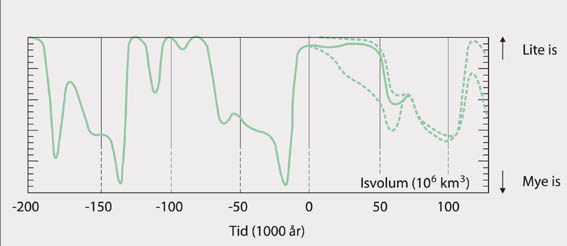 |
| FAR INTO THE FUTURE: The modelled volume of ice from 200 000 years ago until 150 000 years into the future. This indicates that the next ice age will be less extensive than the last one, and that the present interglacial will last a long time yet. |
When the glaciers had their greatest extent during the last Ice Age, the vast ice sheet had its western limit on Andøya in north-western Norway. The ice stretched some 1500 kilometres southwards to Hamburg, northwards right up to the Arctic Ocean, and the eastern limit was far away in Russia. The enormous, up to 3000-metre-thick ice sheet, covered both land and sea. So much water was bound up in the ice that the oceans stood 120-130 metres lower than today.
- The incredible changes in the physical natural environment during the last glacial period are a result of natural climatic changes on the Earth. Ice ages have come and gone with ordered regularity caused by variations in the solar radiation reaching the Earth, Eiliv Larsen emphasises.
Human influences on the climate
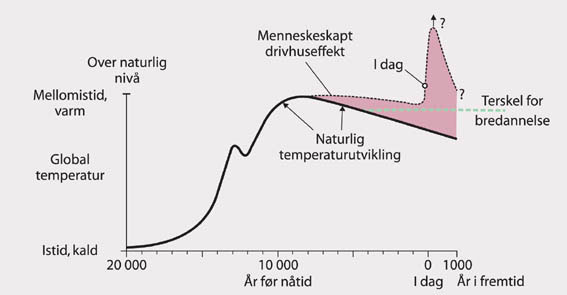 |
| EMISSIONS: For a long time, human emissions of greenhouse gases have been delaying the natural cooling and at the same time preventing a build up of ice in the northern regions. The model also shows that the greenhouse effect will continue to increase until all fossil fuels have been used up. |
Now that the Earth is also encountering human impacts on the climate, it is no longer just a matter of small, cyclic changes in the Earth’s orbit round the Sun, its angle of inclination and the slow rotation of the Earth’s axis. Mankind has created great uncertainties in the dynamic natural variations in climate.
- But what does this really mean?
- In the long term, the natural trend is towards a colder climate, but we will scarcely encounter a real ice age before some 50 000 years hence, Eiliv Larsen believes.
- We now live in a period with a limited extent of ice. The exceptions are Greenland and the Antarctic, where there is almost as much ice as during the glacial period. Glaciers are, nevertheless, retreating now in response to the warmer climate. Global warming brought about by man may continue for many centuries, until all the fossil fuels have been used up. Norwegian glaciers are obviously at risk in this perspective, Eiliv Larsen says.